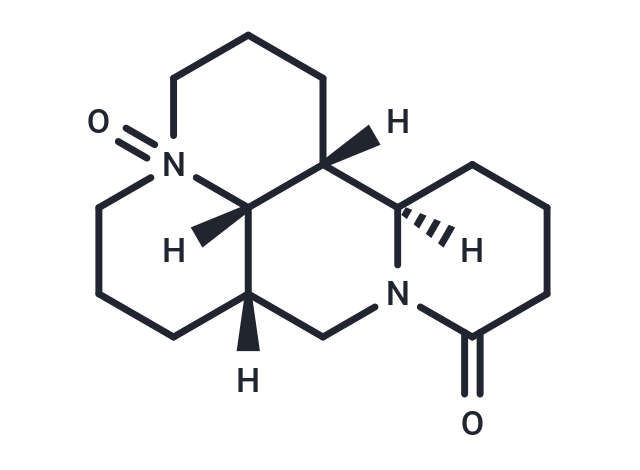Shopping Cart
Remove All Your shopping cart is currently empty
Your shopping cart is currently empty
Oxymatrine (Oxysophoridine) is an alkaloid isolated from Sophora flavescens, used as the antibiotic. It is a traditional Chinese medicine used in the treatment against hepatitis B virus.It can also inhibit iNOS expression and TGF - β / Smad pathway.

| Pack Size | Price | USA Warehouse | Global Warehouse | Quantity |
|---|---|---|---|---|
| 50 mg | $41 | In Stock | In Stock | |
| 100 mg | $59 | In Stock | In Stock | |
| 200 mg | $89 | In Stock | In Stock | |
| 500 mg | $128 | - | In Stock | |
| 1 g | $178 | - | In Stock | |
| 1 mL x 10 mM (in DMSO) | $65 | In Stock | In Stock |
| Description | Oxymatrine (Oxysophoridine) is an alkaloid isolated from Sophora flavescens, used as the antibiotic. It is a traditional Chinese medicine used in the treatment against hepatitis B virus.It can also inhibit iNOS expression and TGF - β / Smad pathway. |
| In vivo | LD50 in mouse: 521 mg/kg, i.p. |
| Kinase Assay | P450 Inhibition Studies: Pooled human liver microsomes (HLM) from at least 15 donors are used for all inhibition assays. For IC50 determinations, the substrate probes are used at their approximate in vitro Km values. All incubations are performed with 100 mM potassium phosphate buffer (pH 7.4) and 1 mM NADPH. For CYP1A2 inhibition study, incubations are performed in a total volume of 0.5 ml, in duplicates with 0.1 mg/ml HLM, 30 μM phenacetin, 1 mM NADPH, and in the presence of avasimibe (0, 0.3, 0.75, 1.5, 3, 7.5, 15, 30, and 40 μM in 50 mM) in a potassium phosphate buffer at pH 7.4. After preincubation at 37 °C for 7 min, NADPH is added to initiate the enzyme reaction. The reaction mixture is quenched with 500 μl of ice-cold 100 ng/ml paracetamol-D4/CH3CN after 25 min. The standards (4-acetamidophenol, singlet) and quality controls (triplicates for low, medium, and high) are prepared at room temperature. After mixing, 0.2 ml of the samples is transferred to another plate and submitted for LC/MS/MS analysis after centrifugation at 3000 rpm for 10 min. A Supelco Discovery Amide C16, 100 × 2.1 mm (5-μm particle size) column (Supelco, Bellefonte, PA) is used. The mobile phase is isocratic, 40:60 [acetonitrile/formic acid, 0.1% (v/v)] at 0.2 ml/min. |
| Cell Research | DU145, PC-3 and PNT1B cell lines (3×104 cells/well) are seeded into 96-well plates and incubated overnight at 37°C in 5% CO2. Subsequently, the cells are incubated with different concentrations of oxymatrine (0, 2, 4, 6 and 8 mg/mL). MTT (10 mL; 5 mg/mL) is added and the mixture is incubated in darkness at 37°C for 2 h. Absorbance is measured at a wavelength of 490 nm using a microplate reader[2]. |
| Synonyms | Oxysophoridine, Matrine N-oxide |
| Molecular Weight | 264.36 |
| Formula | C15H24N2O2 |
| Cas No. | 16837-52-8 |
| Smiles | O=N12[C@@]3([C@@]([C@@]4(N(C[C@@]3(CCC1)[H])C(=O)CCC4)[H])(CCC2)[H])[H] |
| Relative Density. | no data available |
| Color | White |
| Appearance | Solid |
| Storage | Powder: -20°C for 3 years | In solvent: -80°C for 1 year | Shipping with blue ice/Shipping at ambient temperature. | |||||||||||||||||||||||||||||||||||
| Solubility Information | DMSO: 125 mg/mL (472.84 mM), Sonication is recommended. H2O: 33.33 mg/mL (126.08 mM), Sonication is recommended. | |||||||||||||||||||||||||||||||||||
| In Vivo Formulation | 10% DMSO+40% PEG300+5% Tween 80+45% Saline: 4 mg/mL (15.13 mM), Sonication is recommended. Please add the solvents sequentially, clarifying the solution as much as possible before adding the next one. Dissolve by heating and/or sonication if necessary. Working solution is recommended to be prepared and used immediately. The formulation provided above is for reference purposes only. In vivo formulations may vary and should be modified based on specific experimental conditions. | |||||||||||||||||||||||||||||||||||
Solution Preparation Table | ||||||||||||||||||||||||||||||||||||
H2O/DMSO
| ||||||||||||||||||||||||||||||||||||
| Size | Quantity | Unit Price | Amount | Operation |
|---|

Copyright © 2015-2026 TargetMol Chemicals Inc. All Rights Reserved.